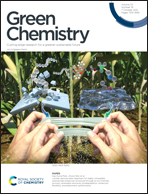Adjusting SiO2 : C mole ratios in rice hull ash (RHA) to control carbothermal reduction to nanostructured SiC, Si3N4 or Si2N2O composites†
Abstract
We report here extracting SiO2 as spirosiloxane [(CH3)2C(O)CH2CH(O)CH3]2Si from rice hull ash (RHA) to carefully control the SiO2 : C mole ratios, allowing direct carbothermal reduction to SiC, Si3N4, or Si2N2O without the need to add extra carbon and as a mechanism to preserve the original nanocomposite structure. We can adjust SiO2 : C ratios from 2 : 15 to 13 : 35 simply by reacting RHA with hexylene glycol (HG) with catalytic base to distillatively extract SiO2 to produce silica depleted RHA (SDRHA) with SiO2 contents of 40–65 wt% and corresponding carbon contents of 60–35 wt% with specific surface areas (SSAs) of >400 m2 g−1. On heating SDRHA40–65 at 1400–1500 °C in an Ar, N2, or N2–H2 atmosphere, XRD patterns reveal formation of SiC, Si3N4, or Si2N2O as the major phase with some residual hard carbon. SEM studies reveal mixtures of particles and whiskers in the products, which show BET specific surface areas >40 m2 g−1 after oxidative removal of excess carbon. Dilute acid and boiling water prewashing of RHA with milling eliminates typical product impurities compared to those found using conventional carbothermal reduction of agricultural wastes, which qualifies the resulting composites as components for electrochemical energy storage devices among other applications, to be reported elsewhere.



 Please wait while we load your content...
Please wait while we load your content...